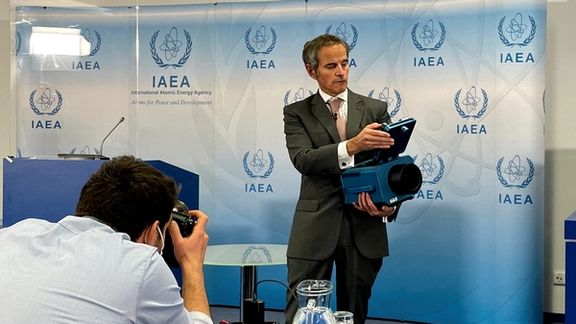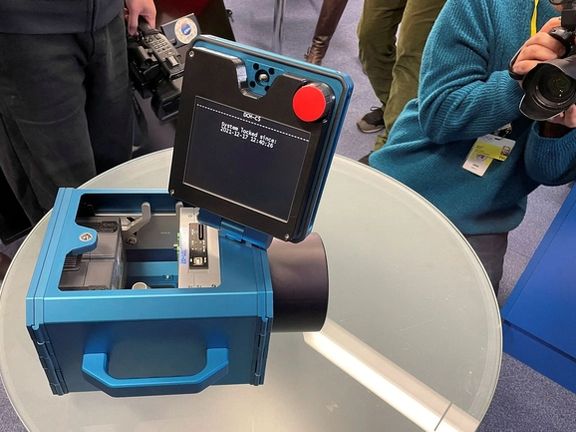Iran Says 10 IAEA Cameras Reinstalled In Esfahan Nuclear Site

Iran has reinstalled ten cameras of the UN nuclear watchdog in one of its installations that were removed last year as tensions rose over its nuclear program.

Iran has reinstalled ten cameras of the UN nuclear watchdog in one of its installations that were removed last year as tensions rose over its nuclear program.
Last year, Iran had turned off 27 cameras or monitoring devices installed by the International Atomic Energy Agency (IAEA), when the UN watchdog’s board of governors in June 2022 censured Tehran for its lack of cooperation with the agency and excessive uranium enrichment.
On Thursday, Behrouz Kamalvandi, the spokesman of Iran’s atomic agency, was quoted by local media as saying that ten of these cameras have been reinstalled in Esfahan’s Natanz facility, which is a major enrichment center, which apparently has a centrifuge production facility making the machines used in uranium enrichment.
He added that the centrifuge manufacturing center in Esfahan is the same Karaj centrifuge production line – the TESA Karaj, a now decommissioned workshop in the west of the capital Tehran -- that was moved to a safe place aftera June 2021 attack that Iran said Israel was responsible for. The IAEA had confirmed that the production of centrifuge rotor tubes and bellows at TESA Karaj Complex has stopped.
An IAEA report cited by Reuters said Iran had informed the agency on January 19 that it intended to “produce centrifuge rotor tubes and bellows at a new location in Esfahan, instead of at the centrifuge component production workshop at the TESA Karaj complex, and that the Agency could adjust its surveillance and monitoring measures accordingly.”

According to Kamalvandi, the data stored in the re-installed cameras will remain with Iran and the agency will not have access to them until the JCPOA nuclear agreement is restored.
A law passed in Iran in December 2020, the IAEA does not have automatic access to the manufacturing process or to the cameras’ footage. Under current arrangements covering nuclear sites, Iran is storing data from cameras and other monitoring equipment but has said the agency will not have access to the data until and unless the signatories find a way to restore the 2015 nuclear deal, the JCPOA (Joint Comprehensive Plan of Action).
The IAEA is responsible for monitoring and verifying Iran’s compliance with the 2015 nuclear deal, which limited the country’s nuclear activities in exchange for sanctions relief, but Iran has been gradually scaling back its commitments under the JCPOA in response to the US withdrawal from the agreement and the re-imposition of sanctions.
The US nuclear watchdog can continue its monitoring of Iran’s nuclear program through other means, including satellite imagery, but the loss of the cameras raised concerns about the agency’s ability to detect any potential covert activities.
Since early May, IAEA Director-General Rafael Mariano Grossi had been saying that the agency was installing cameras and reconnecting some online monitoring systems as part of an agreement between Tehran and the agency. However, as soon as that agreement had been announced in March, the Atomic Energy Organization of Iran and IAEA offered a different interpretation about what it would include, raising questions about its implementation.
The news about Iran reinstalling the cameras came on the heels of reports about Tehran and Washington holding indirect talks to sketch steps that could limit the Iranian nuclear program, release some detained US citizens and unfreeze some of the Islamic Republic’s funds abroad.
Reuters reported on Friday that these steps would be cast as an "understanding" rather than an agreement which would require a review by the US Congress, where many oppose giving Iran benefits because of its military aid to Russia, domestic repression and its support for proxies that have attacked US interests in the region.
American officials have dismissed reports of an impending interim deal, using carefully constructed denials that leave open the possibility of a less formal "understanding" that could avoid congressional review.
Foreign Ministry spokesman Nasser Kanaani also rejected the possibility of an interim or partial deal, emphasizing that they are only after the revival of the JCPOA in its entirety.
Denying the existence of such a deal, US State Department spokesman Matthew Miller said Thursday that Washington wanted Tehran to de-escalate tensions and limit nuclear activities, cease support for regional proxy groups, halt support for Russia's war on Ukraine and release detained US citizens. "We continue to use diplomatic engagements to pursue all of these goals," he added, without giving details.
Reuters cited an unnamed Iranian official as saying: "Call it whatever you want, whether a temporary deal, an interim deal, or a mutual understanding - both sides want to prevent further escalation."